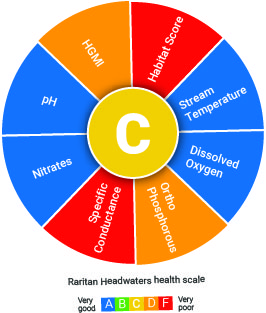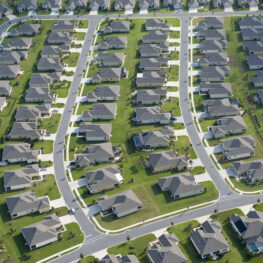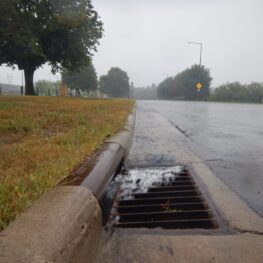 The Health of the Upper Raritan
The Health of the Upper Raritan
RHA’s stream monitoring data, gathered every June by a team of RHA scientists and dedicated volunteers, forms the basis of this annual watershed report card; this is a resource for individuals, municipalities, and government agencies to better understand where in the Upper Raritan streams are healthy and where they are in need of improvement.
This annual watershed report card relies on stream monitoring data collected each June by RHA’s scientists and a dedicated team of citizen scientists. Stream health in the watershed varies. Based on 2023 data on macroinvertebrates, habitat quality, and factors like temperature and pollution levels (measured through chemical parameters) collected at our monitoring sites, the overall watershed received a C grade. While this indicates some areas for improvement, the interactive map within this report provides a more detailed picture. Healthy streams exist alongside those requiring restoration efforts.
The good news: temperatures and oxygen levels in most streams are ideal for clean water and a thriving coldwater fish population. However, there are areas requiring attention. Phosphate levels, likely from fertilizers and wastewater, along with specific conductance, a measure of road salts, are elevated. Additionally, stream habitat quality needs significant enhancement. Given our critical role as the headwaters of the Raritan River, supplying drinking water to 1.8 million New Jersey residents, we are committed to achieving A grades across all water quality parameters.
What caused this rating?

Suburban Development
This report card highlights key areas for improvement: protecting forests and streamside buffers (riparian buffers) and controlling stormwater runoff. Limiting development that creates hard surfaces (impervious cover) and installing green infrastructure that mimics natural water absorption are crucial steps. Implementing best management practices on farms is also essential. Finally, building resilience against climate change is paramount for the health of our waterways.
The current threats to our region’s waterways are multifaceted. Poorly planned development contributes significantly. Furthermore, the cumulative impact of irresponsible management of hazardous materials, fertilizers, pesticides, failing septic systems, and other common pollutants further degrades water quality. Increased precipitation and extreme weather events due to climate change exacerbate these problems.
However, there’s hope. Most of our stream impairments are caused by non-point source pollution, which means it originates from scattered sources like human activities. Fortunately, this type of pollution can be effectively managed by reducing stormwater runoff and capturing rainwater on-site using rain gardens. The good news is that everyone in our community can play a vital role in protecting our watershed by taking action at home, in their backyards, and within their businesses.

Stormwater Runoff
Your help is needed
Many people take clean water for granted, but we know it takes vigilance and hard work to protect the water in our rivers, streams and homes. RHA is the watershed watchdog for the Upper Raritan River region.
And we can’t do it alone. We need your help to ensure that everyone within our reach has access to safe, clean water that is swimmable, fishable and, above all, drinkable.
